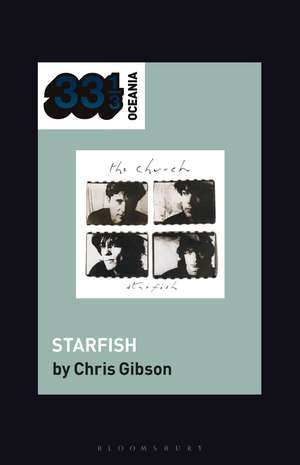The Church's Starfish: 33 1/3 Oceania
Autor Chris Gibsonen Limba Engleză Paperback – 13 iul 2022
| Toate formatele și edițiile | Preț | Express |
|---|---|---|
| Paperback (1) | 111.80 lei 3-5 săpt. | +17.75 lei 7-13 zile |
| Bloomsbury Publishing – 13 iul 2022 | 111.80 lei 3-5 săpt. | +17.75 lei 7-13 zile |
| Hardback (1) | 372.87 lei 6-8 săpt. | |
| Bloomsbury Publishing – 13 iul 2022 | 372.87 lei 6-8 săpt. |
Preț: 111.80 lei
Preț vechi: 122.09 lei
-8% Nou
Puncte Express: 168
Preț estimativ în valută:
21.39€ • 22.34$ • 17.71£
21.39€ • 22.34$ • 17.71£
Carte disponibilă
Livrare economică 15-29 martie
Livrare express 01-07 martie pentru 27.74 lei
Preluare comenzi: 021 569.72.76
Specificații
ISBN-13: 9781501387005
ISBN-10: 1501387006
Pagini: 160
Dimensiuni: 127 x 197 x 14 mm
Greutate: 0.18 kg
Editura: Bloomsbury Publishing
Colecția Bloomsbury Academic
Seria 33 1/3 Oceania
Locul publicării:New York, United States
ISBN-10: 1501387006
Pagini: 160
Dimensiuni: 127 x 197 x 14 mm
Greutate: 0.18 kg
Editura: Bloomsbury Publishing
Colecția Bloomsbury Academic
Seria 33 1/3 Oceania
Locul publicării:New York, United States
Caracteristici
An overview of an all-time classic Australian album that is also an enduring record globally
Notă biografică
Chris Gibson is a Sydney-based musician and writer, and Professor of Geography at the University of Wollongong, Australia. His books include Sound Tracks: Popular Music, Identity and Place (2003), Music Festivals and Regional Development in Australia (2012), Outback Elvis (2017) and The Guitar: Tracing the Grain Back to the Tree (2021).
Cuprins
Prologue Side 11 Destination2 Under the Milky Way3 Blood money4 Lost 5 North, South, East, and WestSide 26 Spark7 Antenna8 Reptile9 A New Season10 Hotel WombPostscriptAcknowledgments EndnotesIndex
Recenzii
It is the best well-written account and perfectly expresses the character of the band members as well. I can thoroughly recommend it.
In his contribution to the 33 1/3 Oceania series, Chris Gibson provides an engaging, insightful look at Starfish, the album that dragged The Church into the surreal world of late-1980s Los Angeles and left them both better-known internationally and forever altered (for better or worse) by the experience. Inviting Gibson, a cultural geographer, to author the book was a stroke of genius. His geographer's eye and musician's ear enable him to capture what is so distinctive about a band that combines the construction of sonic cathedrals and the enigmatic exploration of inner space. Even for fans who have spun Starfish thousands of times, Gibson's narrative opens up new ways of hearing and understanding both the album and the powerful convergence of personal, cultural, geographic, and musical circumstances that produced it. His chapter on the album's ominous opener, "Destination," is especially noteworthy, weaving together pieces of the band's artistic own journey with sharp observations about the construction of a song that remains as stubbornly impenetrable as it is enticing. Drawing on focused, revealing interviews with the band members, later chapters provide memorable stories about legendary Church tracks such as "Under the Milky Way", "Reptile", and "Hotel Womb". Along the way, Gibson also paints a sharp and sensitive picture of the big-city, big-label environment and the punishing studio regimen that yielded one of the most timeless records of the 1980s.
In his contribution to the 33 1/3 Oceania series, Chris Gibson provides an engaging, insightful look at Starfish, the album that dragged The Church into the surreal world of late-1980s Los Angeles and left them both better-known internationally and forever altered (for better or worse) by the experience. Inviting Gibson, a cultural geographer, to author the book was a stroke of genius. His geographer's eye and musician's ear enable him to capture what is so distinctive about a band that combines the construction of sonic cathedrals and the enigmatic exploration of inner space. Even for fans who have spun Starfish thousands of times, Gibson's narrative opens up new ways of hearing and understanding both the album and the powerful convergence of personal, cultural, geographic, and musical circumstances that produced it. His chapter on the album's ominous opener, "Destination," is especially noteworthy, weaving together pieces of the band's artistic own journey with sharp observations about the construction of a song that remains as stubbornly impenetrable as it is enticing. Drawing on focused, revealing interviews with the band members, later chapters provide memorable stories about legendary Church tracks such as "Under the Milky Way", "Reptile", and "Hotel Womb". Along the way, Gibson also paints a sharp and sensitive picture of the big-city, big-label environment and the punishing studio regimen that yielded one of the most timeless records of the 1980s.















